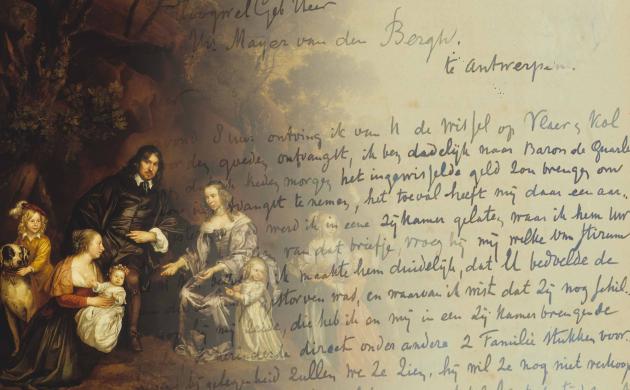Like coming home
Frédéric Charles de Bent, a former member of Henriette's staff, was allowed to visit the museum in 1905. On his visit, she is absent. Therefore, he writes her a letter of thanks afterwards, giving a detailed account of his experience.
De Bent enters through Henriette's house. It is located next to the museum, at 21 Lange Gasthuisstraat. As a former servant, this is a familiar location; he describes the nostalgic feeling that overwhelms him as the house reminds him of his younger years, when he worked for Henriette. He is also impressed with all the technical innovations that have been made in the residence and the museum. For example, Henriette had electric lights installed in the house to properly illuminate the artworks.
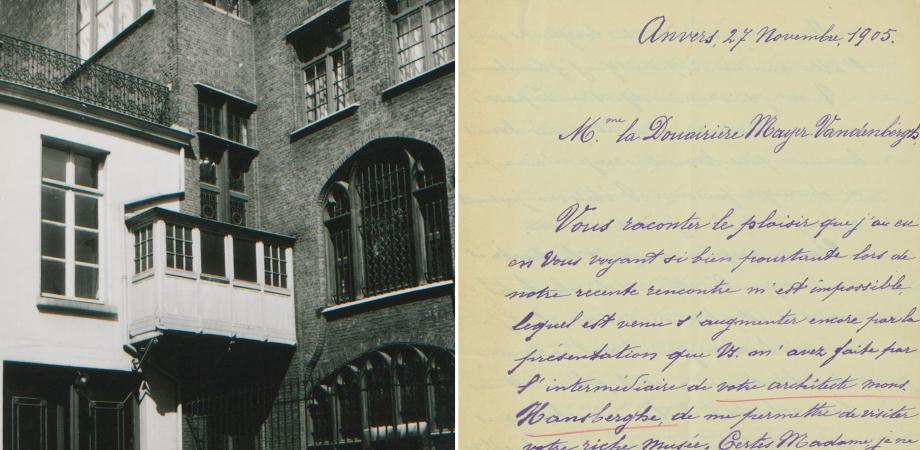
Left: 1965 photo of the passageway between the residence and the museum that De Bent describes and that was later demolished. Right: letter from Frédéric Charles de Bent to Henriette Mayer van den Bergh about his museum visit, 27-11-1905 (MMB.A.1597).
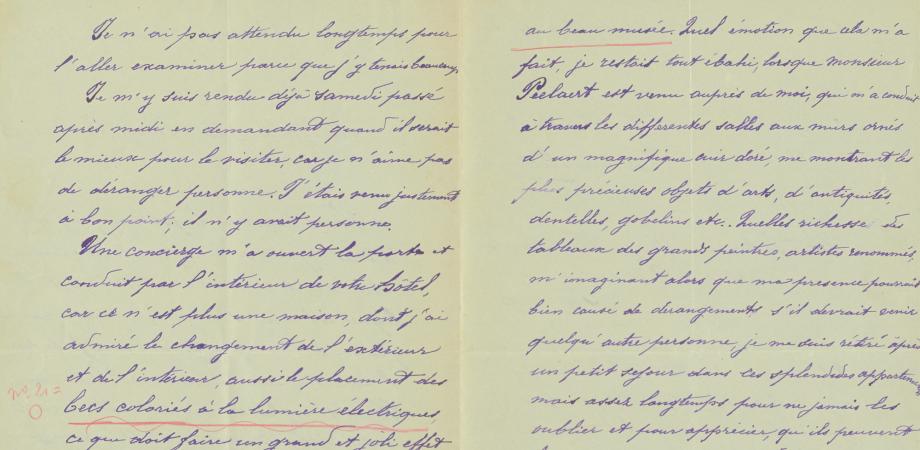
Letter from Frédéric Charles de Bent to Henriette Mayer van den Bergh about his museum visit, 27-11-1905 (MMB.A.1597).
De Bent is led through the hallways of Henriette's home - hallways with ‘the most beautiful, carved furniture’ - to a small room he recognises as a former bathroom. This has been converted and connected to a corridor leading to the museum. De Bent thus enters the Small Gothic Room, where he comes face to face with 15th-century paintings, such as The Lamentation of Christ by the Master of the Prado Redemption.
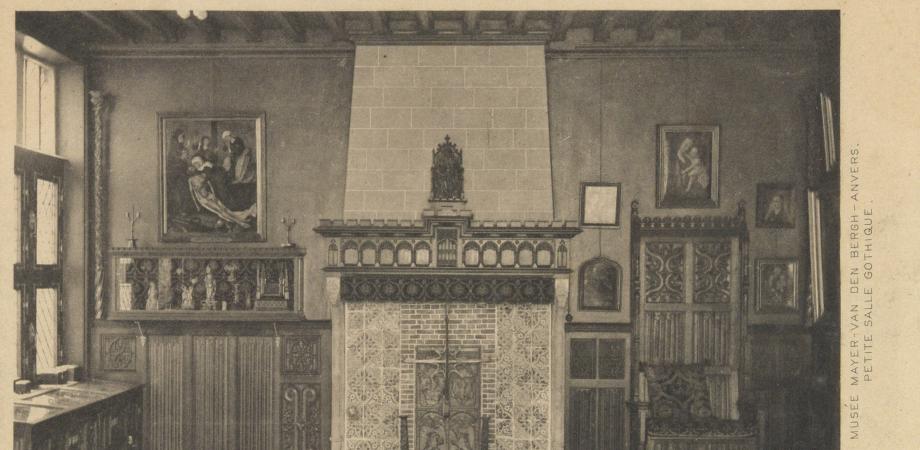
Postcard from the early 20th century, showing the Small Gothic Room. In the corner, you can see the 'Lamentation of Christ'. (MMB.F.191).
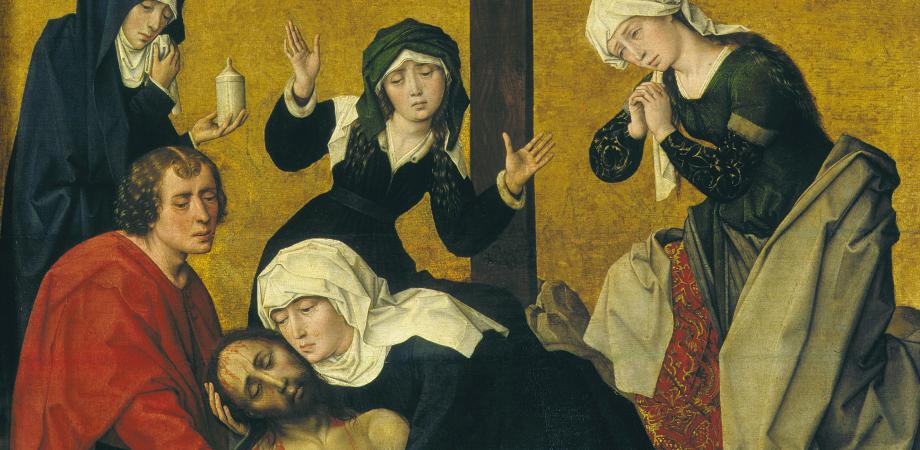
'Lamentation of Christ' by the Master of the Prado Redemption, 1475 - 1499 (MMB.0003).
A tour of the past
Henriette chose a chronological format in her tours; the visitor started with the Gothic period and was led through the Renaissance to the Baroque and the 18th century. As De Bent wrote, guests first entered the Small Gothic Room. "A room full of little masterpieces," wrote Sister Marie Théodorine, a teacher who visited the museum with her class.
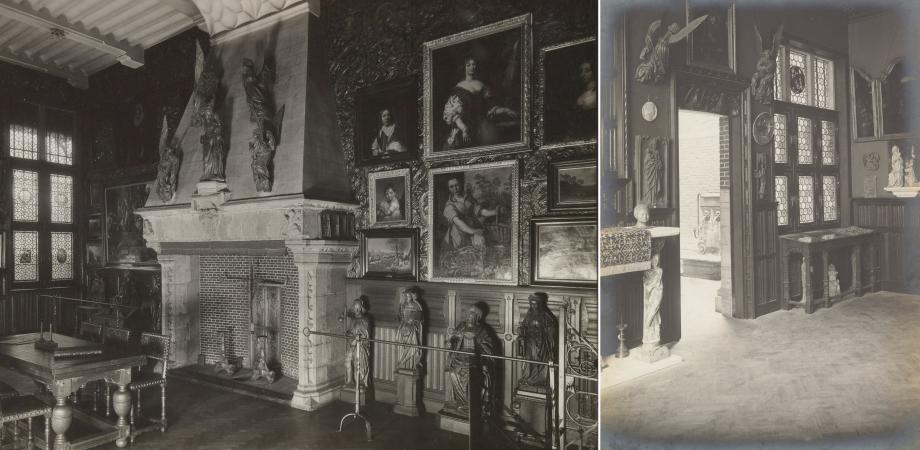
Left: early 20th-century photograph of the Room with the Large Fireplace (MMB.F.276). Right: early 20th-century photograph of the Large Gothic Room. Through the door, you can see the former courtyard which was covered during the 1970's renovation (MMB.F.404).
Then visitors were led downstairs, where they admired the Large Gothic Room and the Room with the Large Fireplace. The Large Gothic Room was demolished in the 1970s, but the Room with the Large Fireplace is still preserved in its original form. Here, you can admire the Flemish portraits. In 1904, sculptures from the collection, including the Christ and St John the Evangelist Group, were also presented in these rooms, along with some historical pieces of furniture.
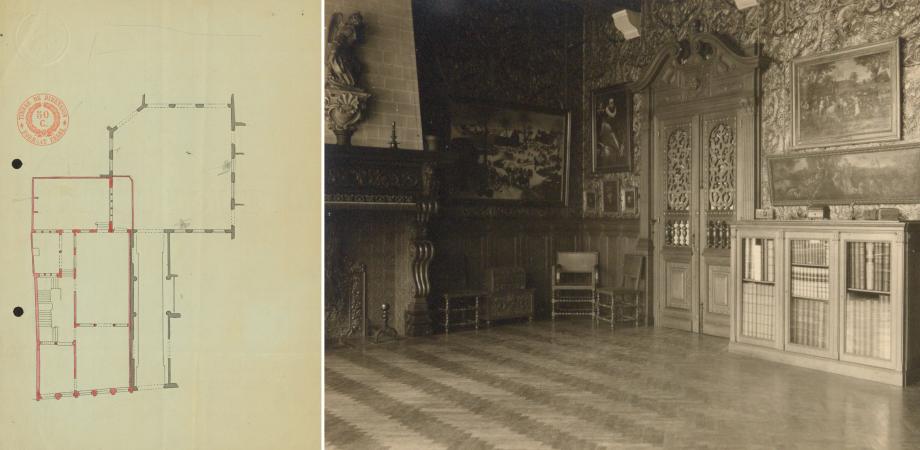
Left: 1903 floor plan of the museum next to the courtyard of Henriette's house. You can see the ground floor in its original condition (MMB.A.2421). Right: early 20th-century photograph of the Renaissance Room. Next to the fireplace today is the passageway to the Micheli Room (MMB.F.200).
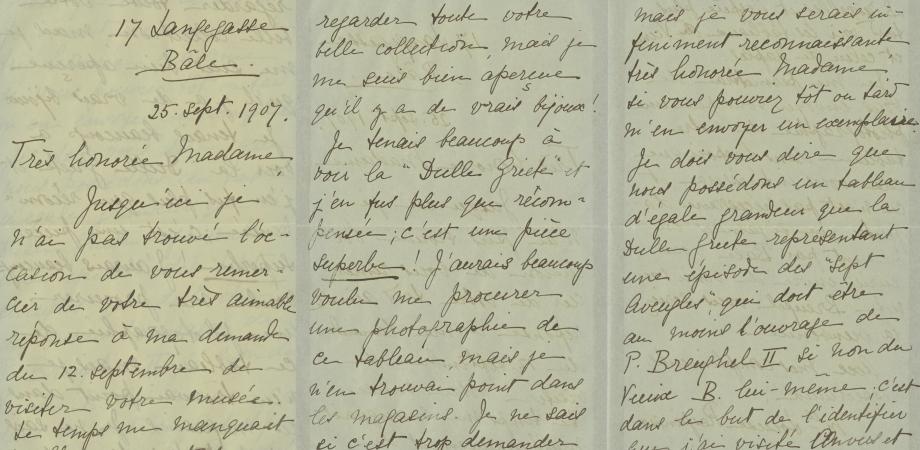
Letter from Louise Respinger to Henriette van den Bergh with questions about the 'Dulle Griet' (also known as 'Mad Meg'), 25-09-1907 (MMB.A.2380).
Through the open courtyard and staircase, visitors were led to the Renaissance Room, which included displays of works by the Bruegel family. For many visitors, Mad Meg was one of the highlights; Louise Respinger asked if a photograph of the work could be taken for her. Then they entered the Library, where 17th-century portraits were on display, and ended the tour in the 18th-century Salon, which Henriette had decorated in Louis XVI style.
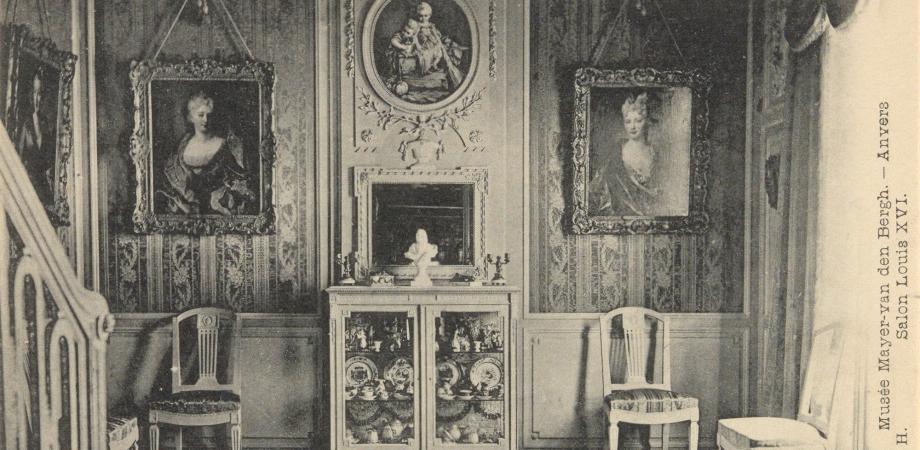
Early 20th-century postcard of the Louis XVI Salon (MMB.F.204).
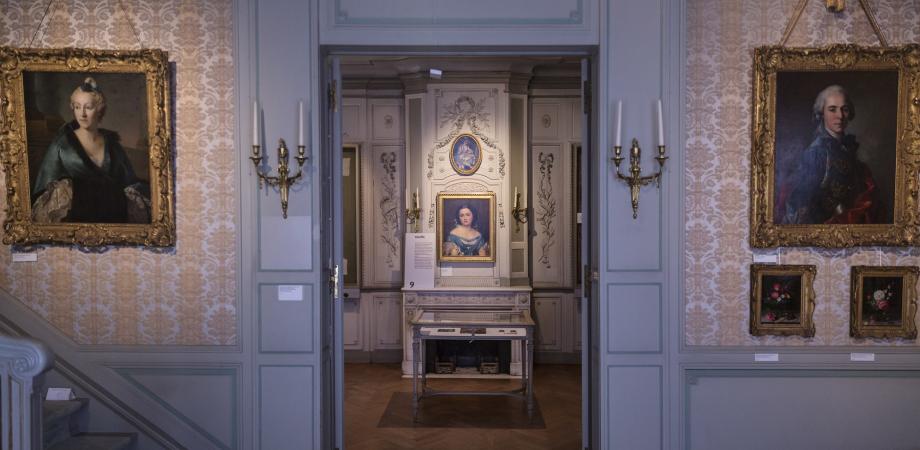
Photo of the current setup (photo: Ans Brys).
Henriette deliberately created spaces that evoked an authentic atmosphere; the visitor saw artworks from different style periods in a historical setting. In this way, she still presented the very diverse collection as a unit. Visitor Henri Rommel wrote that in the museum there are "objects of all times and of all kinds. But all show the enlightened and refined taste of the man who had the patience and fortune to put together such a collection."
An intimate atmosphere
De Bent was let into the museum by Henriette's concierge, but most visitors were shown around by Henriette herself or by her restorer, Juvenal Peellaert. The tours took place in small groups and were therefore very personal. For example, for a group of lace enthusiasts visiting the museum in 1910, Peellaert gave a guided tour during which he focussed on the textile collection. Moreover, Henriette and Peellaert were always willing to pick up works, open drawers and show details. This created an atmosphere of homeliness and intimacy, which the museum visitors greatly appreciated. Peellaert, for example, was described by visitor Père Sylvain Crooij as 'a very courteous and experienced guide'.
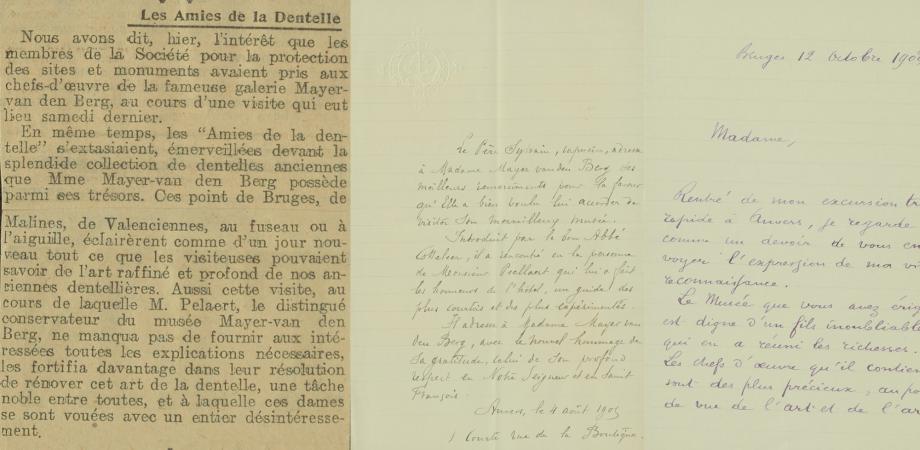
Left: newspaper clipping about a visit by 'The Friends of Lace' to the museum, 20-06-1910 (MMB.A.2341). Middle: letter from Père Sylvain Crooij to Henriette van den Bergh, complimenting Peellaert, 04-08-1905 (MMB.A.2384). Right: letter from Henri Rommel to Henriette van den Bergh about his museum visit, 12-10-1908 (MMB.A.2373).
In the meantime, the structure of the museum has changed significantly. Since Henriette's death in 1920, visitors no longer enter the museum through her residence, but through the separate entrance on the street. In addition, the museum was renovated in the 1970s, with the courtyard being covered and the Great Gothic Hall being substantially altered. Nevertheless, the atmosphere of 1906 was preserved in Museum Mayer van den Bergh; the works of art are presented as much as possible in accordance with the original arrangement in period rooms.
Back in time
A visit to the Mayer van den Bergh Museum in 1904 was undoubtedly a special experience; visitors first walked through Henriette's own house and were often even shown around by the museum founder herself. Henriette created a museum that offered a total experience, a place where works of art could be seen in a historical context and where guests could have a very personal interaction with the works. Today, the museum's collection can still be discovered the way it was viewed by 19th-century art lovers, with an emphasis on the intimate atmosphere and on personal enjoyment of art. Henriette is no longer there to show us around, but you can sense her vision in the museum to this day.



